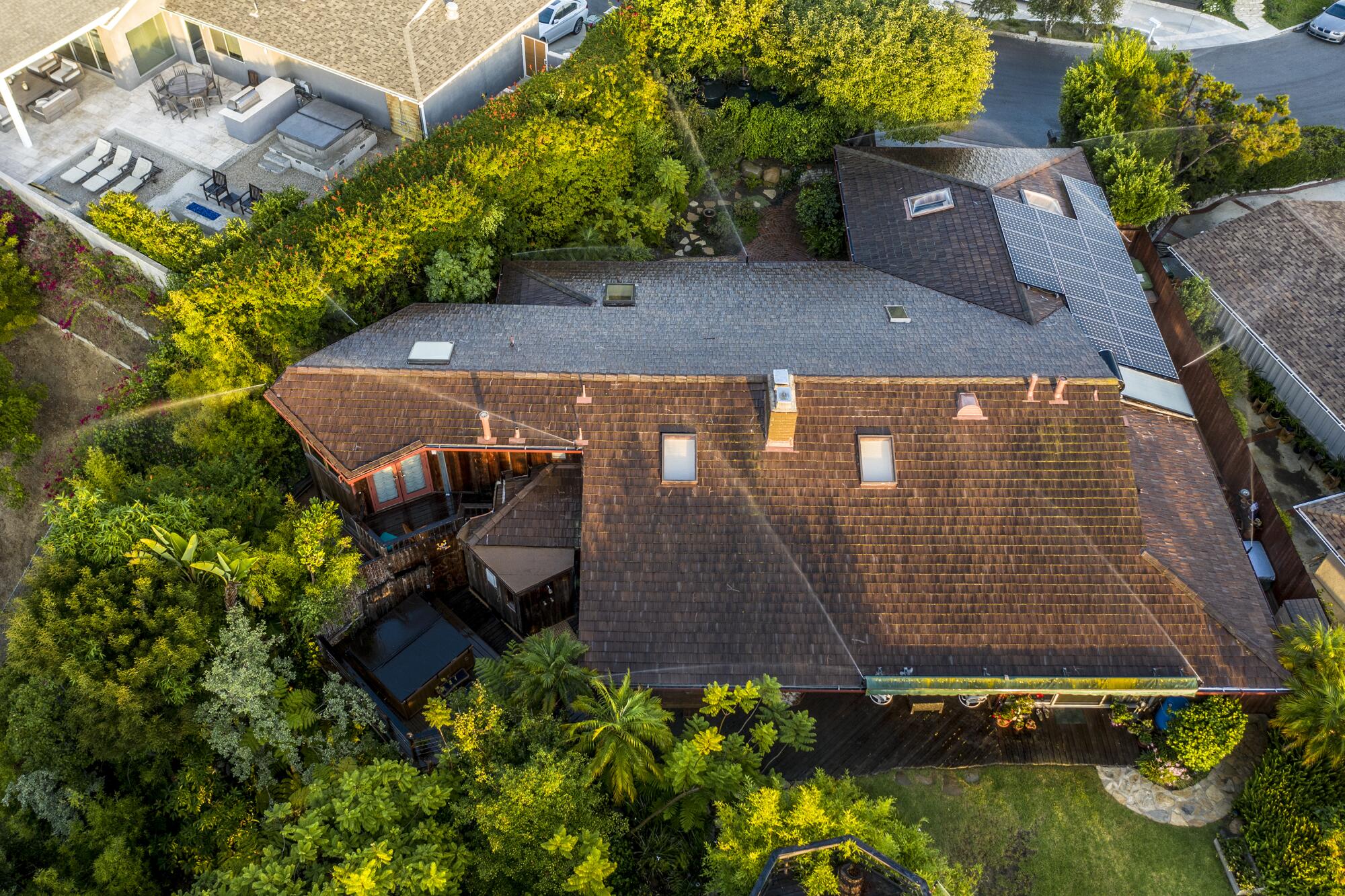
Steve Yusi lives in a high-risk fire zone, and he would seem to have all the defenses a homeowner could want to survive Southern California’s next inferno.
He has installed sensors under the eaves of his Palisades home, reportedly able to detect flames licking on the structure’s wooden exterior. The sprinklers on the roof and garden rotate 360 degrees to create a halo of water and retardant that lasts at least 20 minutes.
Yusi’s eyes widened as he showed off his fire-defense system. Then he met Jack Cohen, who had some bad news.
Cohen, a renowned wildfire expert, has seen what sprinklers do in extreme wind-driven fires — they miss their target. He’s also seen communities lose power, hydrants run out of water and firefighters become overwhelmed as showers of red-hot embers spark hundreds of spot fires in a neighborhood.
In wind-driven scenarios, protecting a home hinges on the little things — such as using the right building materials and maintaining a lush, manageable garden — over pricey projects such as sprinklers, Cohen said. Embers should be viewed as a contagion that can spread like an airborne virus.
“If we don’t mitigate together, we will surely burn together,” Cohen said.
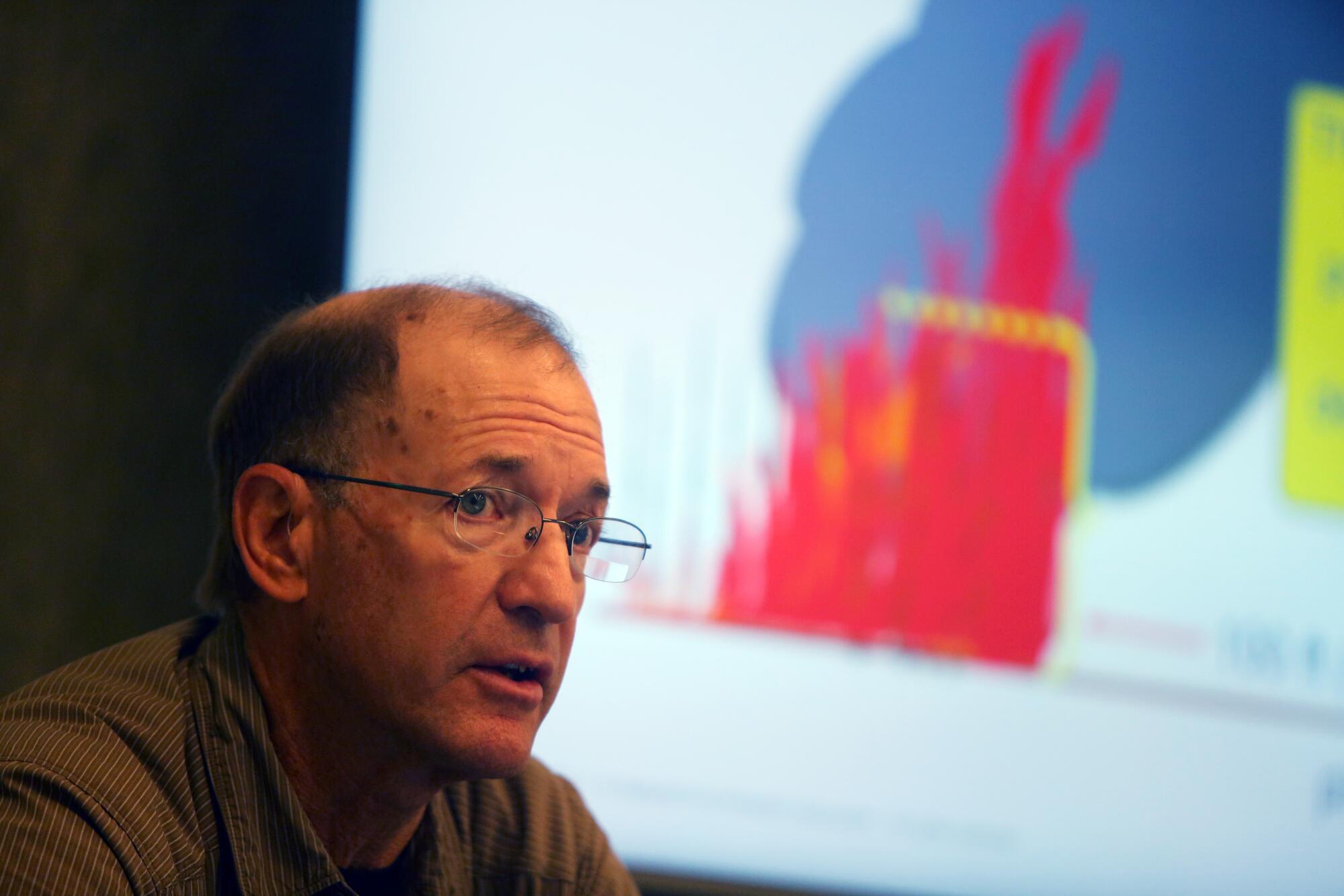
As California’s wildfires have become more destructive, many homeowners are spending thousands of dollars on sprinklers and other elaborate systems to protect their homes.
But experts say such investments offer limited, if any, protection from the wind-driven firestorms that in recentyears have destroyed tens of thousands of homes and killed scores of people. They say that effective landscaping should be prioritized.
Safeguarding homes individually is nowhere as effective as what communities can do together, Cohen said. Events in Santa Rosa and Paradise, Calif., show that perceived protections such as freeways or firebreaks are no match for wind-driven conflagrations.
The key to avoiding the next catastrophic fire, experts say, is a term used by public health officials: group immunity.
The North Bay wine country fires in 2017 revealed how the weakest links in a neighborhood can cost everyone. Firebrands — burning wood — from the Tubbs fire blasted down the slopes separating Napa and Sonoma counties amid gale-force winds, jumped U.S. 101 and ignited the community of Coffey Park where homes stood less than 10 feet apart.
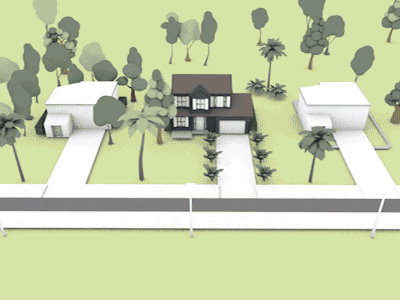
“That’s where I’m an advocate for [fire] coding … so you don’t get a high level of contagion from house to house,” Cohen said of the community’s layout.
Launching a group effort can be more difficult than individually protecting homes, but increasingly, communities are banding together to do just that.
“It’s going to take every individual person having that commitment,” said Beth Burnam, 62, who leads the North Topanga Canyon Fire Safe Council and has worked to educate her neighbors for years. “Unless you try, you’re not going to get there.”
Which led her to join a class being taught by Cohen over the summer.
Considered by many to be the godfather of wildfire home ignition science, Cohen traveled this summer to Los Angeles from his home in Missoula, Mont., to conduct a three-day mitigation session for residents and firefighters. Afterward, he toured the Palisades — where expensive residences are situated on steep hillsides of bone-dry chaparral overlooking Pacific Coast Highway between Malibu and Santa Monica — to assess the risk and provide guidance.
It’s in areas like these across the West, where suburban life flirts with the edge of untamed wildland, that traditional, modern firefighting methods such as aircraft bombardment and clearing land for fuel breaks have failed to stop the worst wind-driven blazes.
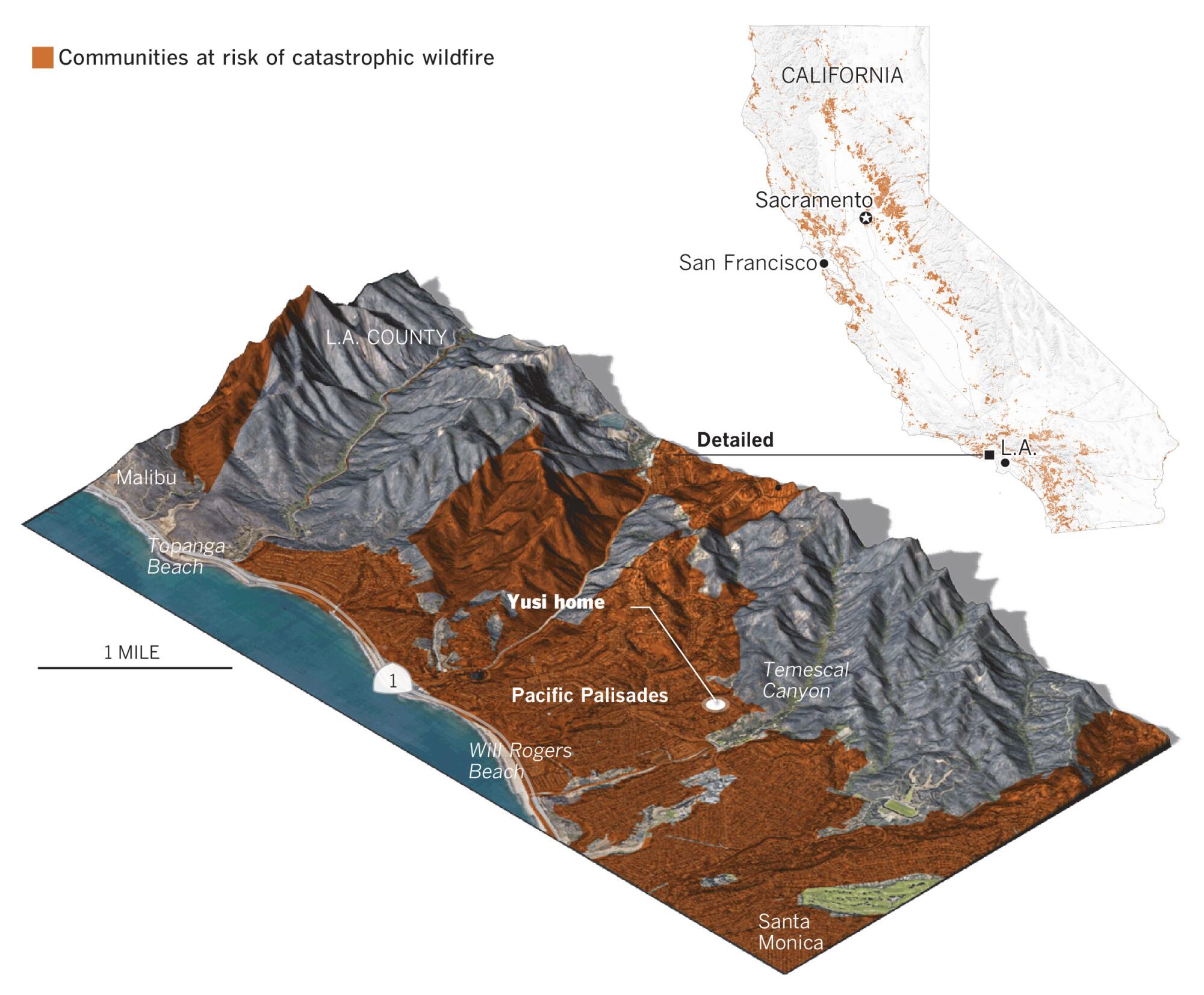
Residents and officials, Cohen said, instead must focus on a defense strategy that starts from the home and moves outward, including some fixes that won’t necessarily break the bank.
His prescription was bitter medicine for Yusi, his wife and many in their neighborhood near Temescal Canyon Park.
The couple had paid for the $75,000 sprinkler system by putting off replacement of their 17-year-old Honda Civic and other domestic expenses. They assumed the system would protect them from the kind of firestorm that scorched their neighborhood once before, and threatened to do so again during last year’s Woolsey fire. Cohen doused those hopes.
“Really?” Yusi said when he heard the news, deflated. “I want herd immunity. That’s why I took that course.”
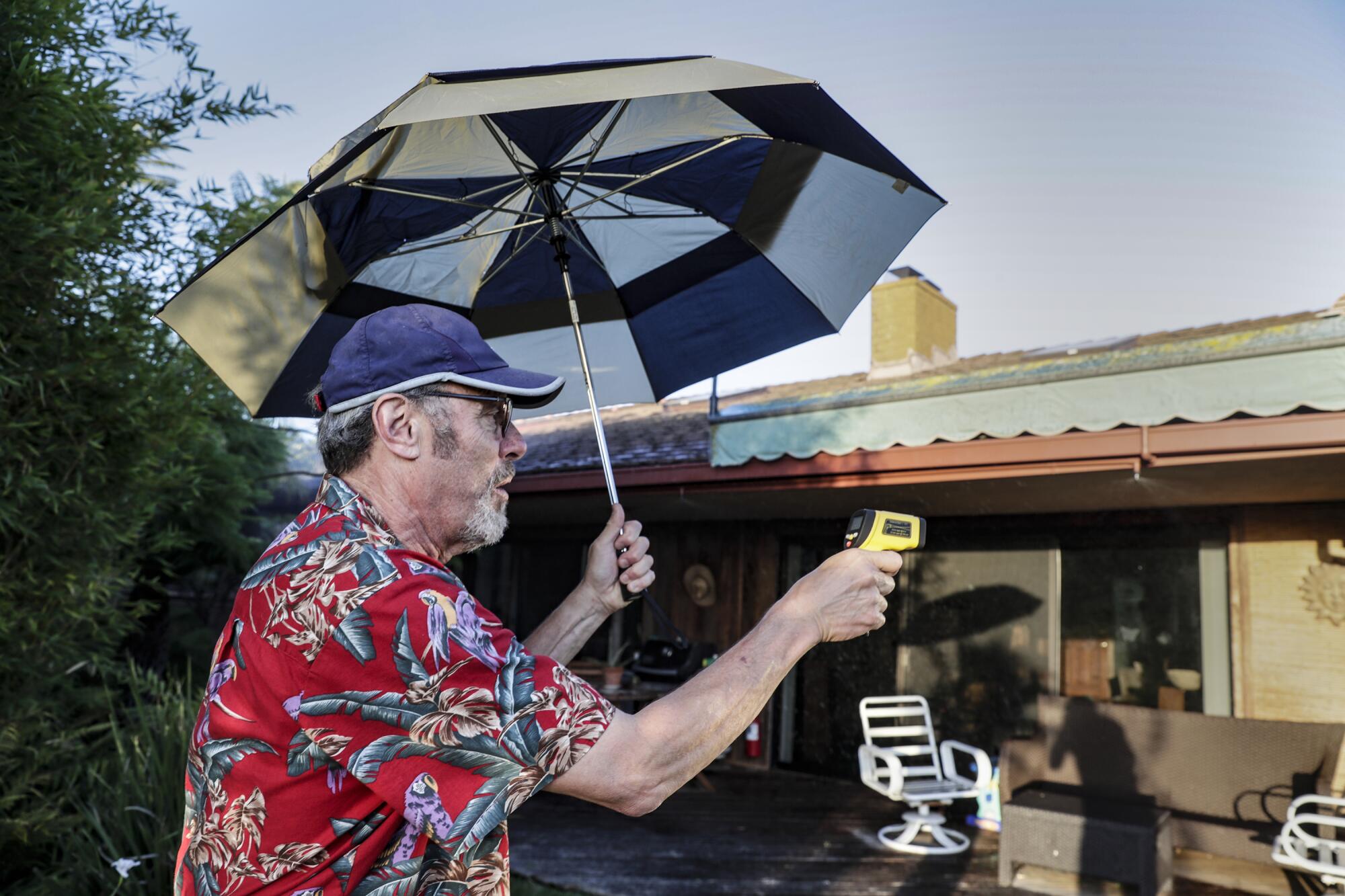
Cohen’s grim diagnosis started just inside the front yard of the Yusi property, where he pointed out a 10-inch-wide gravel strip between the home and the garden. He crouched, pushed his hand between green plant leaves and grabbed a handful of dead and dying vegetation layered beneath — kindling that could feed a fire.
The embers could spark a small fire that could burn the garden’s dead under-story, then spread to the wood fence that overlaps with the gravel and crawl to the home’s siding like a slow-burning fuse.
Cohen then walked to a back corner of the property, where wood steps connected to the home jut out, providing a gorgeous view of the neighborhood. Unfortunately, the steps also are within arm’s reach of a thicket of 6-foot-high plants entangled in the wood fence, providing another path for flames to spread to the structure with one inopportune wind shift.
Details matter in protecting homes from firebrands.
Fine wire mesh vent screens help keep out embers. Fire-resistant construction materials and well-maintained landscaping can prevent fires from spreading. If a home is ablaze and is close enough to a neighbor — as is the case in most foothill communities across California and the West — there’s a chance a single infected house could turn into an epidemic.
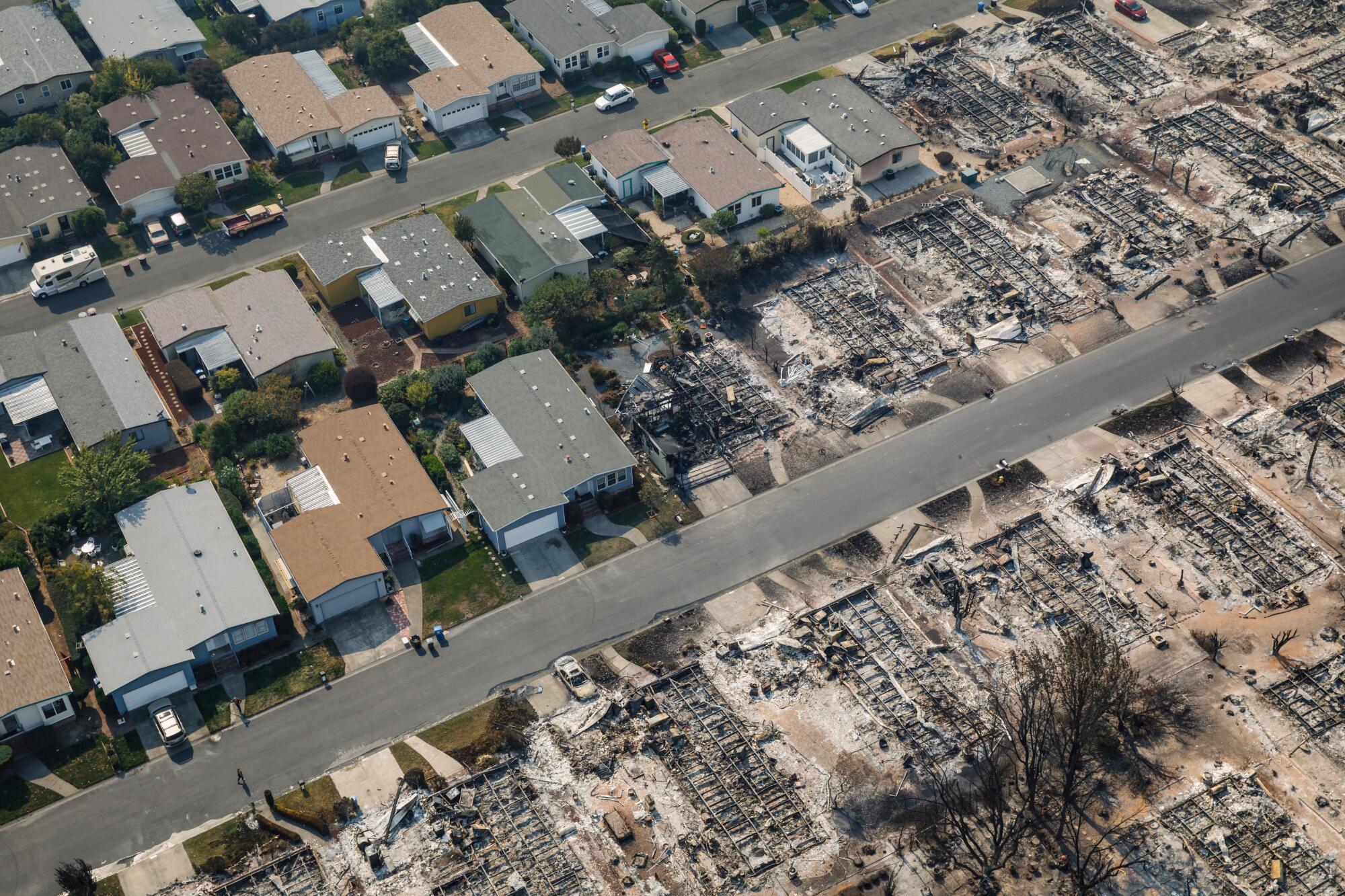
A former hotshot firefighter, Cohen sees climate change and human folly combining to create ever-more dangerous wildfire conditions.
A century of aggressive fire suppression has left forests thick with spindly trees and brush, dried out by drought and steadily increasing temperatures. At the same time, frequent fires in some suburban foothills have allowed invasive, fast-burning plant species to encroach on homes, which are proliferating across the West’s mountain regions.
According to a 2017 study in the Proceedings of the National Academy of Sciences, home building in the wildland-urban interface increased 41% nationwide between 1990 and 2010 — to 41.3 million homes.
Whereas Native Americans used fires to replenish vegetation, that symbiosis disappeared as Europeans spread across North America.
“Ironically, we have this high-tech, European culture coming into the land of low-tech … and suddenly we find ourselves today not being compatible with fire as Native Americans were in the Great Plains. To me there’s no greater irony than that,” Cohen said.
Thus far, California’s approach to managing risk has focused on controlling fire through fuel reduction and prescribed burn programs. The California Department of Forestry and Fire Protection slated 35 different projects for 2019, with their environmental reviews fast-tracked by the California Natural Resources Agency.
The problem, some say, is that even as Cal Fire officials boast they quickly put down more than 90% of blazes, a small number of wind-driven fires are causing more death and destruction than ever before.
Consider the Camp fire in Paradise last year.
Winds squeezed through a mountain pass and blasted firebrands over natural firebreaks and a branch of the Feather River. They blew directly into the town and smaller communities to the northeast, trapping first-responders and residents alike.
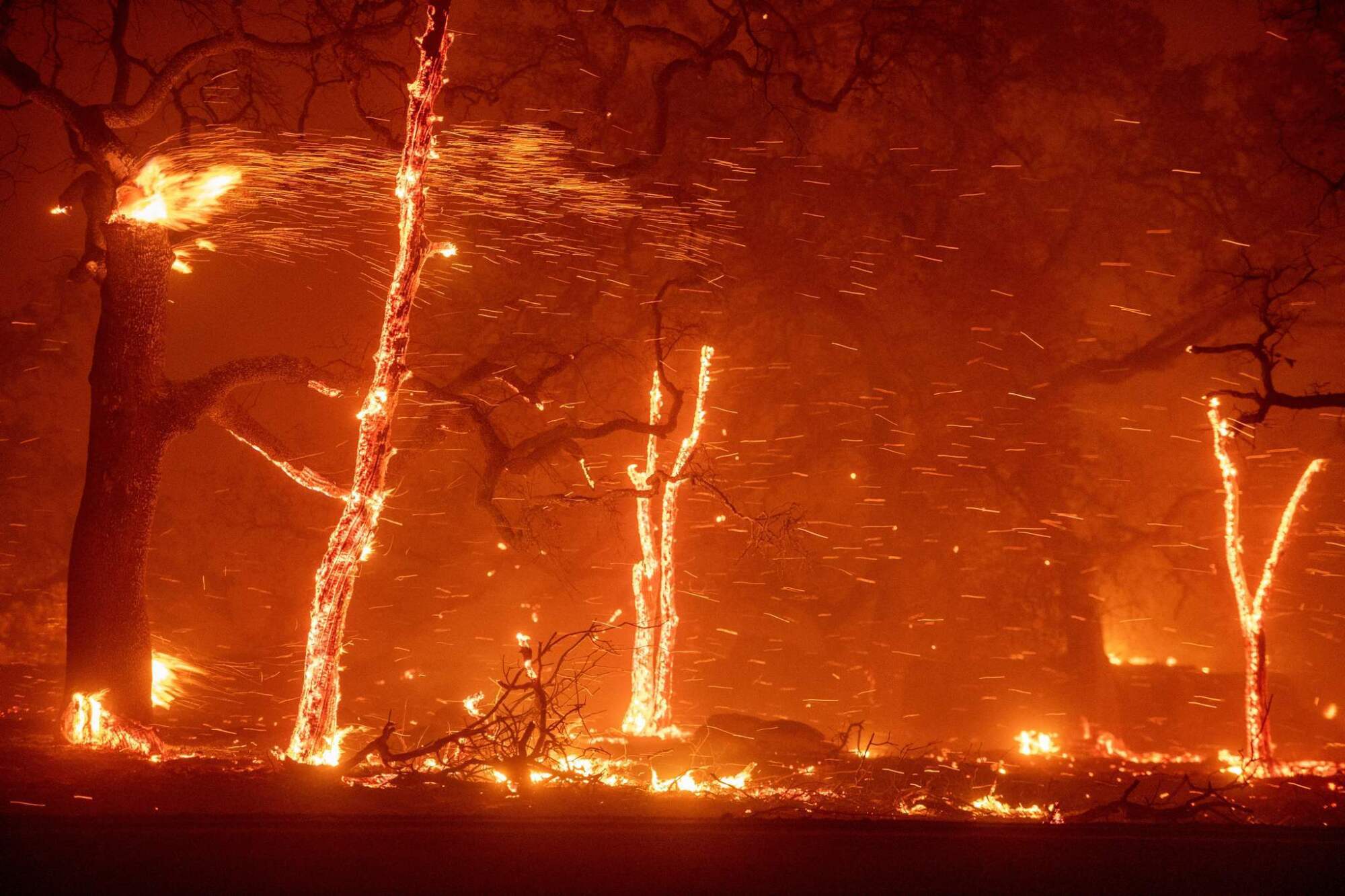
In Southern California, the potential financial losses from extreme wildfires are many times higher. The region has some of the nation’s highest concentrations of expensive homes surrounded by the most flammable ground cover in the Western Hemisphere. Though low-cost maintenance may be the most direct path toward protection, affluent homeowners frequently explore other avenues first.
In Malibu, one resident told Cohen during class that neighbors discussed building a phalanx of ground sprinklers ringing the neighborhood to ward off an incoming fire.
“Nonsense,” Cohen said.
There was also the famous music producer with a Venice studio who suggested the National Park Service dump 50,000 gallons of water on the Santa Monica Mountains once a week through summer to keep the landscape from becoming too dry. That idea is impractical for a host of reasons, experts say.
In the case of the Yusi residence, the homeowners had purchased a sprinkler system that’s never been used in an actual wildfire.
Their house is in a state-designated high-risk wildfire zone, where it’s edged by a slope covered in dry chaparral and coastal sage scrub. The couple is concerned that, should a fire reach those hillsides — as one did in 1978 when multiple homes below were lost — flames and firebrands would storm the community, overwhelm firefighters and take down homes like a row of burning dominoes.
That’s what happened with the Woolsey fire in November in Malibu, when hot, dry winds carried burning embers over firefighters and into the neighborhoods they were assigned to protect. There are never enough firefighters to extinguish the thousands of tiny spot fires that can rapidly erupt in worst-case scenarios.
“This is one of the fundamental characteristics of wildland-urban fire — overwhelming our resources,” Cohen said.
Which is why slowing down its spread is essential, he told residents and firefighters.
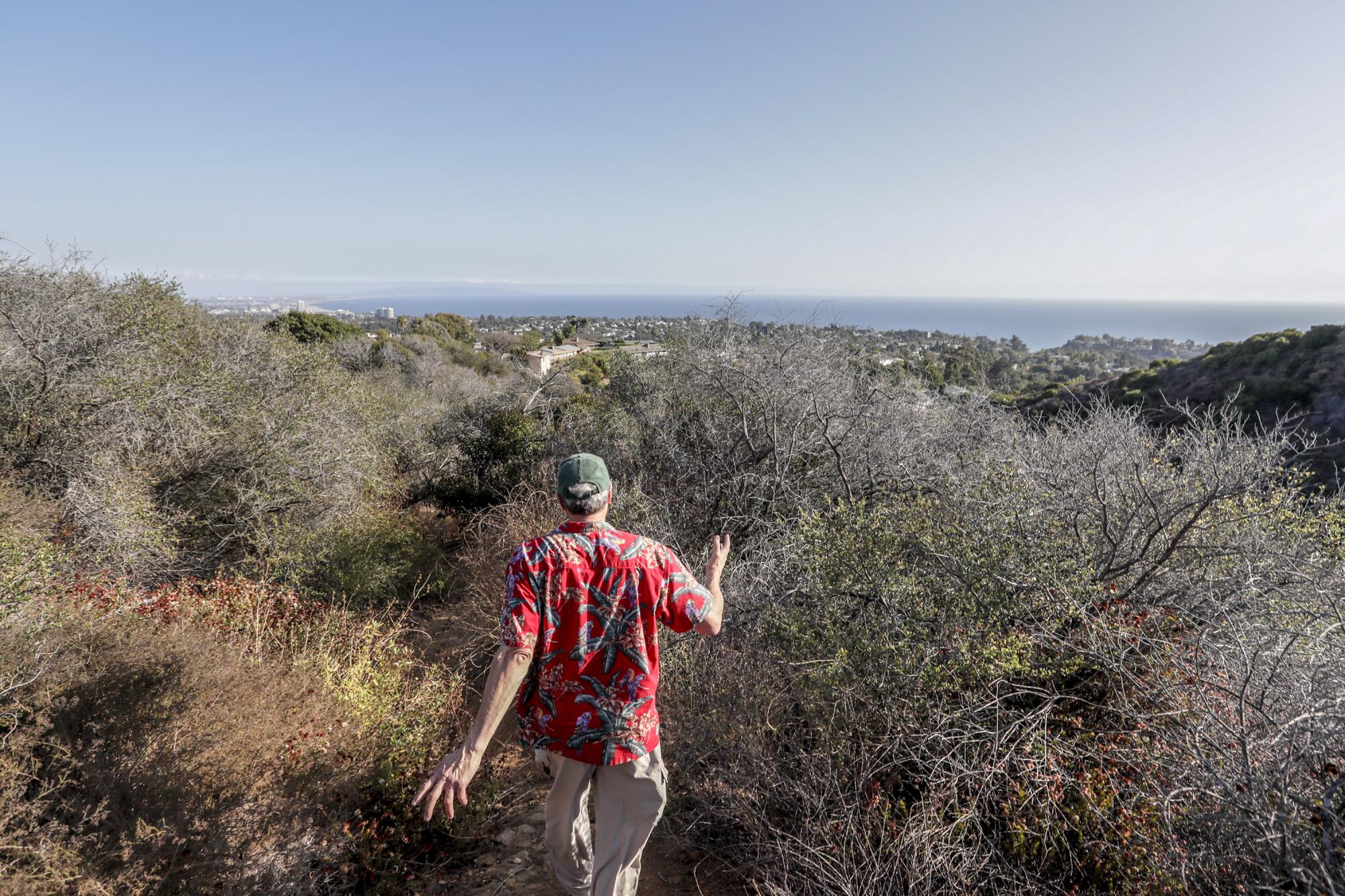
Home-hardening should be viewed on a gradient that starts with the “structure zone” and the 5 feet around it, then moves outward, Cohen said. The landscaping should be set up in a way that as a fire gets closer to the structure, it slows down and burns less intensely. Trees and bushes should be isolated into islands located 5 to 30 feet and 30 to 100 feet away from the structure.
“What that does is it gives a chance for somebody, maybe a resident, most likely firefighters, to be able to get here, discover it and easily extinguish it. It buys time,” Cohen said. “When they spend less time here and over there and over there ... the more houses that can be protected.”
The importance of the 5-foot “structure zone” was validated during a recent lab test in South Carolina, said officials with the Insurance Institute for Business and Home Safety, an industry organization that focuses on best building practices.
In March, researchers at the IBHS fire lab conducted an experiment in which they exposed a home with a fire-resistant roof to a wind-driven shower of embers. One half of the home was landscaped with drought-friendly bark mulch and plants leading up to wood siding, the other half had gravel landscaping and plants that edged up to fire-resistant siding.
Seconds after the ember shower started, the mulch began burning and ignited the plants. Those flames spread rapidly to the wood siding, and before long, the entire home was engulfed in fire. The other half of the building remained unburned.
That type of mitigation pays dividends across entire neighborhoods, and is the basis for an update to California’s fire codes that’s on the governor’s desk awaiting his signature.
A 55,000-acre wildfire near Durango, Colo., last summer is an example of the zoned approach’s effectiveness, Cohen said. That blaze threatened the community of Falls Creek Ranch, which is surrounded by conifers in the San Juan National Forest. For a decade, residents there have fully embraced a culture of self-reliance in preparing for inevitable wildfire, according to Cohen and local media.
For three days each year the community gets together, clears their parcels of flammable debris and then has a potluck. Last summer, the fire reached the edge of town, but not a single home was lost.
The success of a community-wide approach also bore fruit in 2007, during the Witch fire in San Diego County. During that October fire storm, five fire-hardened developments in Rancho Santa Fe remained standing while surrounding neighborhoods burned. One home suffered damage when embers ignited a scrap of particle board leaning against the garage. A sprinkler system doused that fire before it could engulf the home.
“If wildfires are inevitable and extreme wildfire conditions are inevitable, then firebrands are inevitable,” Cohen said. “And that means we don’t have a decision.”
Miriam Schulman, who lives across the street from Yusi in the Palisades, was instrumental in organizing her neighborhood to tackle its particular threat.
While on vacation in Oahu in 2017, Schulman was checking the news on her phone when her stomach knotted.
She saw flames from the Skirball fire running up the sides of the Sepulveda Pass and, she feared, toward her home.
“I was horrified,” said Schulman, 66. “I wasn’t where I could do anything about it, and I didn’t know what to do about it.”
While the blaze never reached her side of town, the experience left her shaken. As soon as she returned to the Palisades, she went on social media, dialed neighbors, sent emails and searched online for the latest wildfire home-hardening strategies recommended by experts.
That effort ultimately steered Schulman to pools of grant money and eventually, reaching out to Cohen to teach the class.
If enough residents modify their homes for wildfires — and have it validated by local fire officials — some of these Westside communities could be listed as “firewise” by the National Fire Protection Assn., which can lead to insurance discounts. Bel-Air is the only firewise community in Los Angeles County.
As for Yusi’s home, Cohen says, it is a lost cause “without some quick fixes.”
Those are already in the works, the homeowner said. He’s installed smaller vent screens, coated his wood siding in fire retardant and installed metal flashing along the ground, ensuring any embers that hit the walls won’t smolder and burn through.
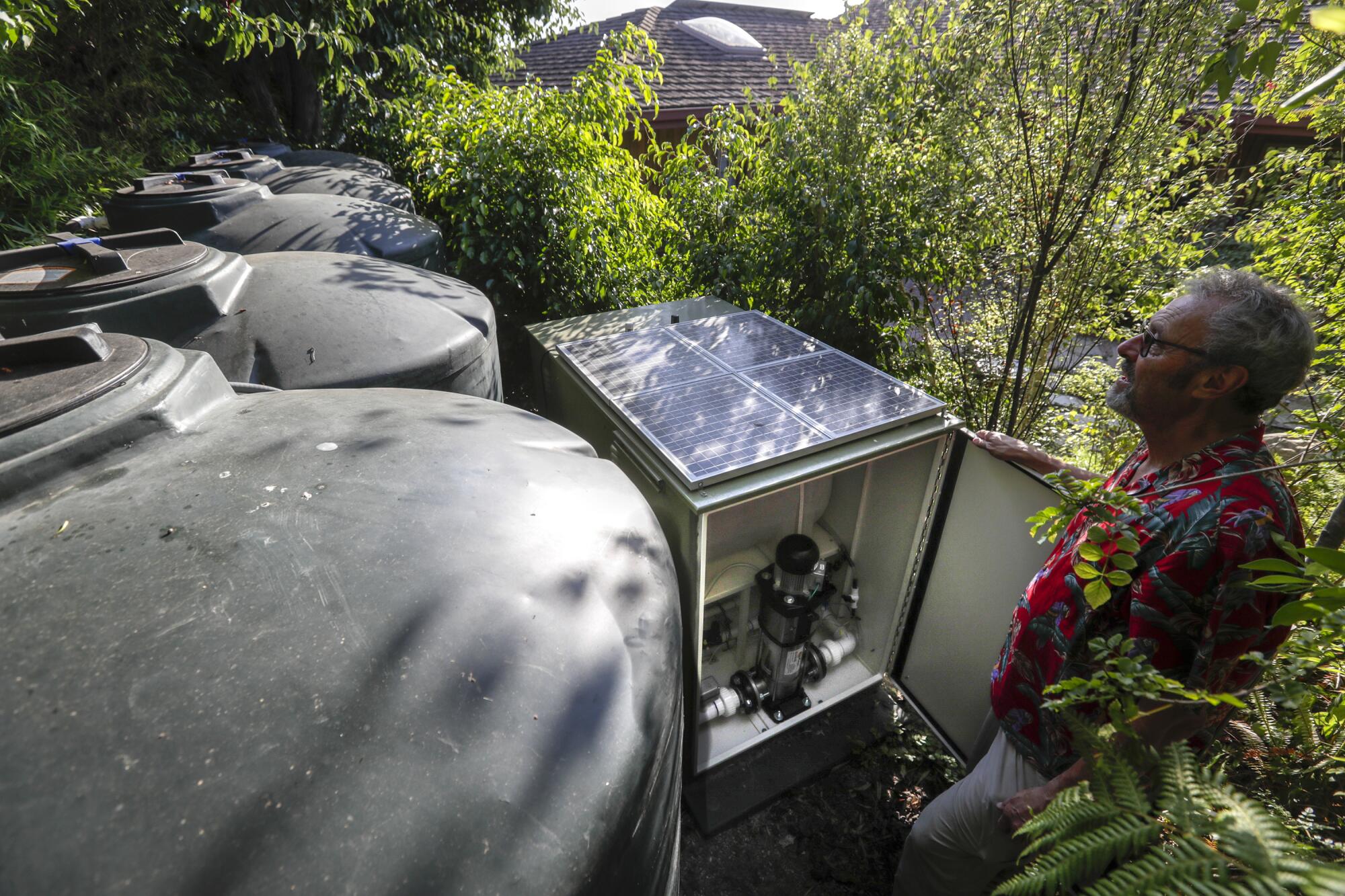
He also has assembled an emergency kit that includes an ample supply of water.
Yusi said that, after the Woolsey fire, “common sense, and paranoia” drove him to buy the fire-suppression system instead of a new car.
“And I must admit, real or not, that there is a sense of security I get from looking at the hedges that hide the [water] tanks, or the sprinklers on the roof, or the fire sensors located around the house,” he said. “I’m still not overly confident, and I just hope we’re never tested.”
Want to read more L.A. Times wildfire coverage? Subscribe here.







